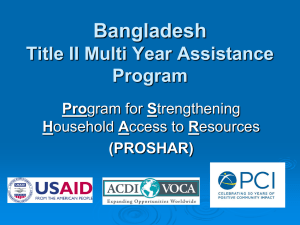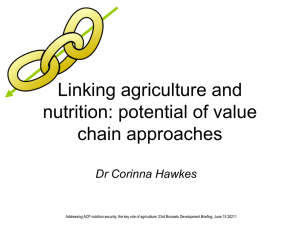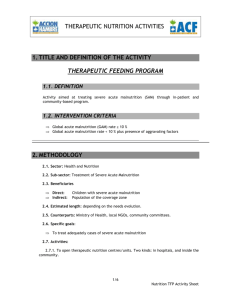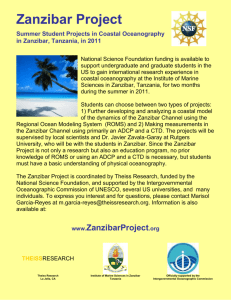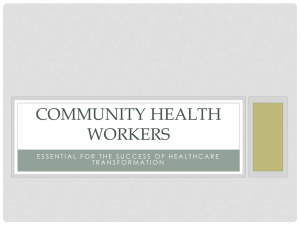1.10 Nutrition AJHSR
advertisement
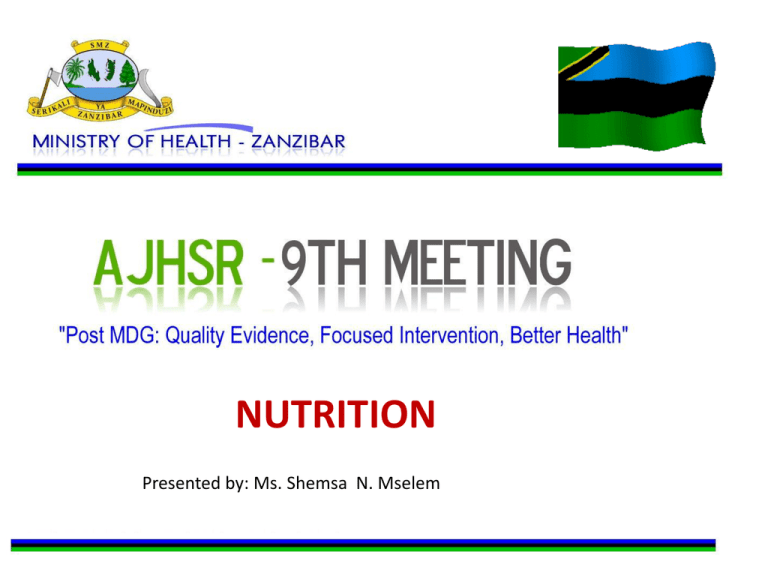
NUTRITION Presented by: Ms. Shemsa N. Mselem Introduction • Good nutrition is a prerequisite for national development and for wellbeing of individuals • Adequate nutrition is essential for health, growth and development • Poor nutrition is an underlying cause of death in children and also plays a significant role in morbidity and mortality from diet related non-communicable diseases in later life TREND IN Malnutrition AMONG <5 yr Zanzibar 60 Prevalence (%) 50 40 30 20 10 0 1992 1996 Stunting 1999 Underweight 2004 2010 2014 Wasting (acute) 3 Trend in stunting among <5 yr in Zanzibar Trend in wasting among <5yr in Zanzibar Status of infant and young child feeding (PROPAN Study 2012) • 20% of children are given other food within three days of birth • Many of the children(6-23 month) do not meet the recommended amounts of their dietary intake Protein and Vitamin C – Most of the children met recommended nutrient intake Energy – slightly more than half of children met the recommended intake Iron, Zinc, Calcium and Vitamin A – Many of the children did not meet the recommended amounts 96 100 90 80 67 70 Percentage Amount of nutrients consumed 60 58 61 55 51 50 40 30 20 11 8.5 7 9 10 0 22 18 0.5 1.4 0 Energy Iron 0.5 0 0.8 Zinc Vitamin A Vitamin C Calcium 7 Achievements • Reduction in 2014 National Nutrition Survey(preliminary results) vs. 2010 TDHS – Stunting 24.4% vs 30% – Underweight 13.9% vs 19.9% – Wasting 7.2% vs 12% • Integrated management of Acute malnutrition(IMAM) – Treatment of Severe Acute Malnutrition(SAM) – Supportive supervision and training of 40 health workers on inpatient care of children with SAM Achievements cont… Micronutrient interventions ; • Vitamin A supplementation coverage (Feb 2014) 77.5% to 98% (2014) during Integrated Measles Rubella campaign (targeted 80%) • Deworming 78.1% to 107% IMR, targeted 80% • HHs utilization of Iodated salt from 49.3% (DHS, 2010) to78.5% NNS, 2014) slightly above 70% targeted, According to WHO when 90% of the HHs are using iodated salt it poised to attain the goal of eliminating iodine deficiency – Training of 200 salt traders on importance of iodating salt – Provision of 200 kg of Potassium Iodate to salt farmers Challenges • Poor coverage of treatment of acute malnutrition (only 1000 children enrolled against targeted 5,000) • Inadequate infant and young children feeding practices (median duration of exclusive breast feeding 2 weeks) • Shortage of nutrition staff in line with scaling up nutrition – Current status of personnel 4 nutritionist in the MOH nutrition unit, 4 on training, – Current requirements at least 20 to cover districts, zone and hospitals Proposed Solutions Implementation of Comprehensive and integrated community health worker program in Zanzibar – To bridge the gap between community and health facilities and increase the uptake of health services – CHWs will be identified and trained on Community infant and young child feeding and management of acute malnutrition (to start with) and will have major task on counseling on IYCF, following up women in the Shehia and screening and referral of acute malnutrition Proposed Solutions: Implementation of Comprehensive and integrated community health worker program in Zanzibar – There will be a team leader among CHWs, and health facility staff will supervise CHWs in the catchment area of the facility. – 1CHW per 500 people (approximately 50 pregnant/lactating women) – Two district to start (North A and Mkoani) – Incentives and regular follow up and feedback Proposed Solutions Scaling up IMAM services – Quarterly active case finding and referral by CHWs • More children identified, more children enrolled and managed Rollout cIYCF program •Community level interventions to address inadequate infant and young child feeding practices Recruitment of nutritionist Each district should have at least one professional nutritionist Finances • 2013-2014 Source of funds RGoZ Unicef Planned finances Funds received 15,117,500 324,787,000 expenditure 430,000 430,000 36,419,500 36,419,500 • 2014-2015 Source of funds Planned finances RGoZ Funds received Expenditure - - 18,821,800 Unicef 445,023,860 151,772,000 56,772,000 2014-2015 plans • Strengthen management of acute malnutrition (trainings, supplies, supervision, active case finding, data quality improvement, quarterly meetings between CHWs and PHCU HS) • Rollout cIYCF (TOT, training of health workers, training of CHWs, counselling mothers/guardians on IYCF both at health facility and community 2014-2015 plans cont .. • IDD (procure KIO3, training of school teachers on monitoring iodated salt, quarterly monitoring of Iodated salt utilization at HH level) Thank You






